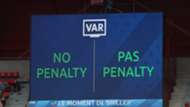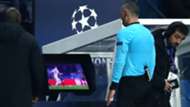
English football has experienced a small taste of VAR, but it will be fully implemented this season in the country’s top division
Having already been rolled out in elite-level competitions across the planet, including the World Cup and the Champions League, VAR will be introduced in the Premier League from 2019-20.
The technology was officially used in competitions such as the Carabao Cup and FA Cup last season, but decision-makers for England‘s top league opted to delay its introduction until this year.
After a season of extensive behind-the-scenes monitoring and testing, PGMOL (Professional Game Match Officials Limited) director Mike Riley concluded that VAR will help referees “make more better decisions”.
As the Premier League gets set to follow Serie A, La Liga and the Bundesliga, Goal takes a look at what will happen with VAR in practice.
How will VAR work in the Premier League?
VAR – the video assistant referee – will operate much in the same way as it does in other competitions.
The purpose of VAR is to aid the referee in making decisions regarding the correction of “clear and obvious errors” during a game.
There are four main areas where incidents can be reviewed: Goals, penalties, red cards and mistaken identity.
The following is the general practice:
- Incident occurs and the referee informs the VAR to review and vice versa.
- The VAR reviews video footage of the incident and advises accordingly whether or not action should be taken.
- Referee accepts the advice of the VAR and makes a call or takes the decision to review the footage first.
Will VAR be different in the Premier League?
There will be some slight differences in the use of VAR in the Premier League, with officials hoping to avoid issues experienced elsewhere.
PGMOL, along with the Premier League, carried out non-live trials in the 2018-19 season and analysed the use of VAR in other competitions in an attempt to hone the practice.
A particular area of concern was the potential for VAR to interrupt the flow of a game and cause confusion among supporters.
Neil Swarbrick, the man leading the implementation of VAR in the Premier League, says that referees in England will adhere to a stricter standard when it comes to video consultations.
“The threshold is higher,” Swarbrick told the Mirror. “It’s different interpretations of the IFAB laws. The different variations we’ve got we hope will stop the long stoppages and the long reviews with the screen.”

By way of example, it has been argued that the contentious penalty given to Liverpool in the 2018-19 Champions League final for a Moussa Sissoko handball would not be given via VAR in the Premier League.
Mike Riley, head of PGMOL, told the Times. “In real time it (Sissoko’s handball) looks a clear penalty.
“With VAR you can actually see what he’s doing, and he’s not interested in trying to block the cross, he’s saying to the covering defender, ‘Get over there and fill the space.’
“That’s not a deliberate act of extending the arm away from the body.
“You also see the ball deflects off the chest on to the arm, and if you put everything together and apply the philosophy we do here, we wouldn’t say that was handball.”
So, in practice, that interpretational divergence may reduce the potential for VAR-rewarded penalties, a fear that has been aired by some in the football community.
How will referees use VAR replays in the Premier League?
Premier League referees have been encouraged to limit the time they use the video review area at the side of the pitch, which has been identified as a notable source of delay in VAR calls.
Instead of reviewing every call flagged by the VAR assistants, it is hoped that match officials will trust the advice given to them by their colleagues. However, the referee can still take time to review if necessary.
Relating to that, the Premier League has taken steps to keep the supporters and those watching the game on TV informed about the process and rationale of decisions.

Graphics will be displayed on screens to explain the reason for a delay in play and the thinking behind any overturned decision.
As well as that, the VAR can also decide to show a definitive video clip, which illustrates exactly why a position was reached, on those screens.
In stadiums where screens are not in use, announcements will be made over the PA system.
Furthermore, in an attempt to make the VAR process as accessible as possible, league officials have indicated that they are exploring the possibility of showing messages and video on an app.

Be the first to comment